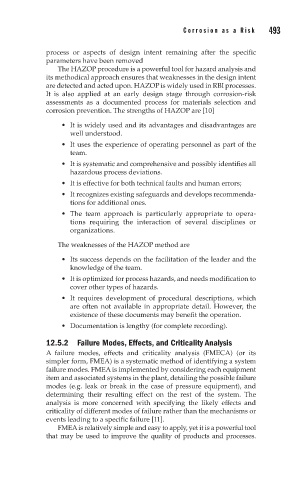Page 527 - Corrosion Engineering Principles and Practice
P. 527
492 C h a p t e r 1 2 C o r r o s i o n a s a R i s k 493
process or aspects of design intent remaining after the specific
parameters have been removed
The HAZOP procedure is a powerful tool for hazard analysis and
its methodical approach ensures that weaknesses in the design intent
are detected and acted upon. HAZOP is widely used in RBI processes.
It is also applied at an early design stage through corrosion-risk
assessments as a documented process for materials selection and
corrosion prevention. The strengths of HAZOP are [10]
• It is widely used and its advantages and disadvantages are
well understood.
• It uses the experience of operating personnel as part of the
team.
• It is systematic and comprehensive and possibly identifies all
hazardous process deviations.
• It is effective for both technical faults and human errors;
• It recognizes existing safeguards and develops recommenda-
tions for additional ones.
• The team approach is particularly appropriate to opera-
tions requiring the interaction of several disciplines or
organizations.
The weaknesses of the HAZOP method are
• Its success depends on the facilitation of the leader and the
knowledge of the team.
• It is optimized for process hazards, and needs modification to
cover other types of hazards.
• It requires development of procedural descriptions, which
are often not available in appropriate detail. However, the
existence of these documents may benefit the operation.
• Documentation is lengthy (for complete recording).
12.5.2 Failure Modes, Effects, and Criticality Analysis
A failure modes, effects and criticality analysis (FMECA) (or its
simpler form, FMEA) is a systematic method of identifying a system
failure modes. FMEA is implemented by considering each equipment
item and associated systems in the plant, detailing the possible failure
modes (e.g. leak or break in the case of pressure equipment), and
determining their resulting effect on the rest of the system. The
analysis is more concerned with specifying the likely effects and
criticality of different modes of failure rather than the mechanisms or
events leading to a specific failure [11].
FMEA is relatively simple and easy to apply, yet it is a powerful tool
that may be used to improve the quality of products and processes.

